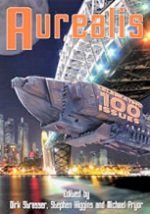“The Cavity” by David Tansey
Reviewed by Adrian McCauley
This is Aurealis’ 100th issue, and as such they have eight stories this month as opposed to the usual few. There seems to be a general theme (or trend) in this issue for experimental fiction that does not rely on clear story arcs or clear endings.
“The Cavity” by David Tansey is a fictional article about a massive geological anomaly discovered deep beneath Australia. The article chronicles it’s discovery and ponders the theories surrounding it. Told through the format of a Wikipedia entry, it is a satirical, hard-science tale that reminded me of works such as many of Jules Verne’s “Extraordinary Voyages” or the seminal tale “Story of your life” by Ted Chiang (popularised as the film The Arrival.) This story is as fascinating as it is satisfying, with so much attention to detail that it demands multiple readings, despite having no real characters or plot.
“Shimmerflowers” by Michael Pryor is weird-fiction at its best. Dark and ominous, surprising and unpredictable. There wasn’t a particularly clear story arc; the main character is too young to have an animal companion and is envious of her sister coming of age, but then a monster arrives and eats her sister. Then, years later, her sister returns, changed in some way, and her animal companion starts to eat everyone else’s companion. Then, in an anti-climactic confrontation, her sister stops being evil for no apparent reason. Pryor’s story stands out with its unsettling tone and very deliberate style and it held me captive up until the end, where it unfortunately fizzled out and left me unsatisfied with its rushed conclusion. With some mild Lovecraftian tones, this story was like reading the transcript from one of my childhood nightmares.
“The Mandlebrot Bet” by Dirk Strasser is a tale of quantum physics and time travel and, as the title suggests, uncertainty. Told in sections, the story jumps back and forth through time and space, while still following a linear narrative. It is an interesting and very enjoyable story, especially if you enjoy hard science fiction with its technical details and lexicon. It made me think and kept me guessing the whole way through.
“The Bewitching of Dr Travidian” by Geoffrey Maloney is a humorous pre-WWI period piece of scandal and melodrama written in the flavour of Mansfield or Dickens and with a light seasoning of witchcraft. The story begins quaintly enough and then descends into pure absurdity towards the end. Though the outcome is predictable halfway through, it is the anticipation of this which carries the reader through to a satisfying punchline.
“The Madlock Chair” By Terry Dowling is a unique science fiction tale that is as confusing as it is ambitious. A follow up to Dowling’s “Flashmen,” this tale assumes the reader knows details, and this lets the story down. There was a real strong footprint of a fantastic idea here; something almost tangible, but ultimately it was too vague and under-realized to be of great enjoyment. Random objects appeared in random locations, possibly a form of interdimensional communication, or possibly a form of hostility. However, the premise was strong enough that it has made me want to seek out that earlier story.
“All We Have is Us” by Alex Isle is an apocalyptic tale set in a world of zombies and scavengers. Though there was an original idea at the start of the story, there was nothing new to add to the already-saturated zombie-genre. Despite being well written with fleshed-out characters and ideas, ultimately I was disappointed with the generic depiction of the zombie inhabited world.
“Forest/Trees” by Stephen Higgins is an allegorical story about the way humans and the environment and technology are all interconnected, and tries to explain these connections through suspense and intrigue. It is a mystery story about nano-technology going rogue and replicating the environment, with the main characters (uncertain of who or what is real) trying to understand what is happening. I felt it started to fall flat toward the three quarter mark, as concepts and ideas introduced throughout the story seemed to be more for decoration than any significant purpose, and as the tale comes to and end it feels incomplete with most questions unanswered.
“Mayfire” by Rebecca Birch is a plain tale. Set in a medieval village, the first half feels like a fairy tale from the Brothers Grimm. However, in the middle the darker tones give way to lighter and more colorful ones, leading to a crescendo that finishes with a ‘happily ever after.’ The writing is great, the ideas and imagery are interesting, but it is another tale which I felt finished too abruptly.
 Aurealis
Aurealis